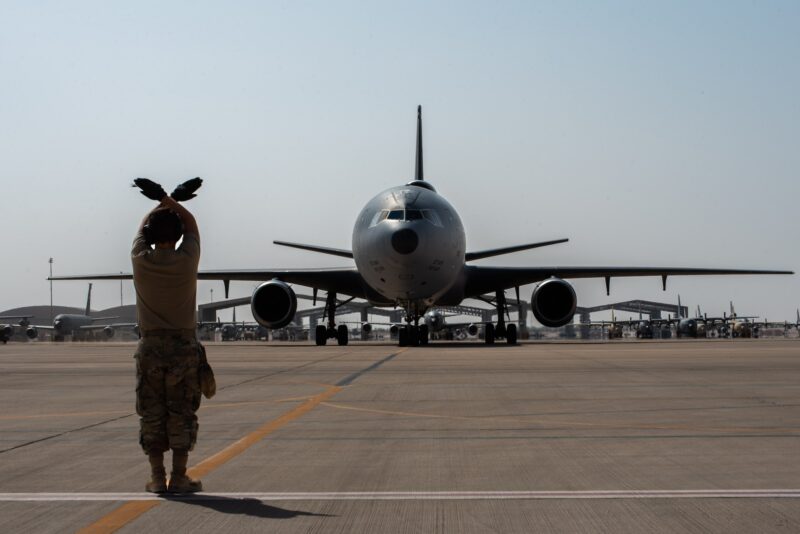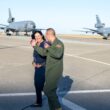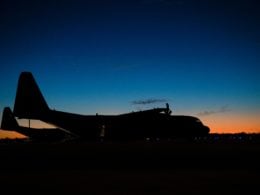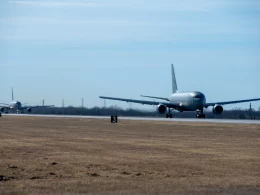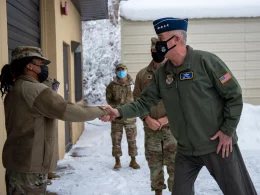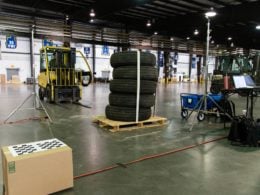PRINCE SULTAN AIR BASE, Saudi Arabia —
In a ceremony on October 4th, 2023, history was made as the KC-10 aerial refueling aircraft, assigned to the 908th Expeditionary Air Refueling Squadron (EARS), was officially deactivated. The event marked the end of an era in military aviation and highlighted the changing landscape of air power in the 21st century.
The KC-10 Extender has been a stalwart workhorse in the United States Air Force’s fleet for decades. Serving as a vital component of the U.S. military’s global reach and power projection capabilities within the AFCENT Area of Responsibility (AOR) and abroad. The massive aircraft carried cargo and passengers in addition to its primary role as an aerial refueler, making it a truly multi-mission platform.
During the inactivation ceremony held on Prince Sultan Air Base (PSAB), Saudi Arabia, Brig. Gen. Akshai Gandhi, 378th Air Expeditionary Wing commander, highlighted the enduring legacy of the KC-10 and the Airmen who have fueled its success.
“In the 1 1/2 years that the KC-10 has been at PSAB, they’ve accomplished over 1,300 missions with over 9,000 flying hours, and delivered nearly 73 million pounds of fuel to over 11,000 receivers,” said Gandhi. “To the entire team that has made the KC-10 the legacy that it is, congratulations on a job well done.”
By September 2024, the U.S. Air Force’s inventory of KC-10s will be decommissioned and gradually replaced by the new KC-46 airframe. Because of this impending transition, U.S. Air Force Maj. Joseph Rush, 908th EARS commander, has led the last combat operations squadron to deploy with the legendary aircraft.
“It’s been a bittersweet deployment,” said Rush. “The KC-10 will continue to fly for the next year until all the tails have retired and crews have cross-trained into the KC-46. It’s exciting for our community, as we get to take a lot of the best parts of the KC-10 culture we’ve built over the last 42 years and bring those best practices and experiences to a brand new weapons system.”
In the AFCENT AOR specifically, the KC-10 has been a vital component of aerial refueling for U.S. and coalition forces for over 30 years. According to Rush, it’s a legacy that signifies the impact of the airframe and reflects the hard work of the pilots, boom operators, and maintainers who have made it all possible.
“The KC-10 has been the anchor of air refueling in the AOR since DESERT STORM,” said Rush. “Thousands of Airmen have deployed to support KC-10 combat operations [and] to be here at the culmination of that legacy is a privilege. We hope to honor the service [of] the aircraft and more importantly the people who dedicated months and years of their lives employing it.”
Looking into the 21st century, the importance of aerial refueling in projecting air power is as important as ever, and a critical need that will continue long past the tenure of the KC-10.
“The ability to refuel another aircraft in the air allows for that aircraft to stay airborne longer and extend its capabilities across vast distances,” said Rush. “For a fighter, aerial refueling can take a 2-hour unrefueled flight time and turn it into an 8-hour combat mission. That translates to uninterrupted Close Air Support coverage for coalition troops on the ground or Defensive Counter Air coverage to high-value airborne assets in a combat zone.”
At the forefront of keeping the aging KC-10 in the air, are the hardworking maintainers who have ensured maximum operability of the aircraft. Despite the hot and sandy conditions, the AFCENT AOR is known for, and the limited availability of parts for the aging aircraft, Airmen of the 378th Aircraft Maintenance Squadron (AMXS) have ensured the KC-10’s last deployment was just as effective as its first.
“To prepare a KC-10 for flight, we typically invest about 3 hours,” said Tech. Sgt. Nikolie Ambriz, 378th AMXS maintainer. “This time is primarily allocated to performing avionics operation checks and conducting thorough visual inspections enabling us to identify potential issues before aircrew arrive at the aircraft.”
As the KC-10 ends its sunset tour and closes an important chapter in the history of military aviation, it serves as a reminder that it’s the people behind the mission, and the bonds they’ve forged together that leave the real legacy.
“The Airmen in the 908th have taken up a “can do” attitude to operations, and we hope to leave a lasting impact on the AOR when we depart,” said Rush. “The culture we’ve fostered and the camaraderie among the crewmembers is second to none.”




